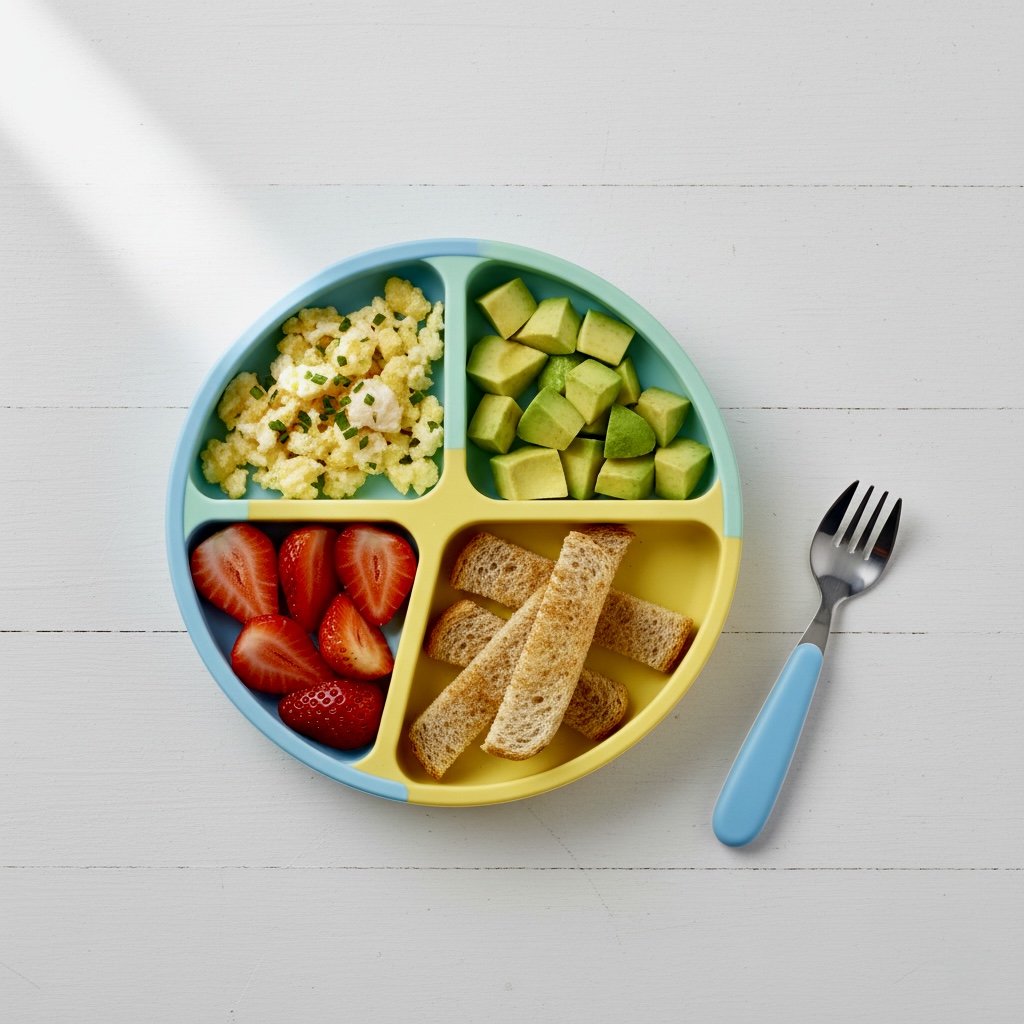Starting your little one on healthy foods for babies and solid is an exciting milestone filled with joy, curiosity, and sometimes a bit of anxiety. Understanding healthy foods for babies is crucial for their growth, brain development, and establishing lifelong eating habits.
Choosing the right healthy foods for babies sets the foundation for their development.
This comprehensive baby nutrition guide will walk you through everything you need to know about feeding your infant and toddler from six months to two years old.

Understanding Baby Nutrition: The Foundation for Lifelong Health
The first two years of life represent a critical window for nutritional development. During this period, your baby’s brain grows faster than at any other time in their life, reaching approximately 80% of its adult size by age two. The healthy Foods for babies you introduce now directly impacts their cognitive development, immune system strength, and future food preferences.
According to pediatric nutrition experts, babies need a balanced combination of proteins, healthy fats, complex carbohydrates, vitamins, and minerals. Unlike adults, babies require higher fat content in their diet to support rapid brain development and growth. This is why breast milk or formula remains essential during the first year, even after introducing solids.
When selecting healthy foods for babies, focus on nutrient density rather than quantity.
Read more: 7 Essential Healthy Foods for Babies: Complete GuideCognitive Development Baby: Milestones: What to Expect in the First Year
The Importance of Iron-Rich First Foods for Infants
Iron deficiency is one of the most common nutritional concerns in infancy. Babies are born with iron stores that typically deplete around six months of age, making it essential to introduce iron-rich first foods for infants at this crucial time. Iron supports brain development, immune function, and helps prevent anemia.
Excellent iron sources include pureed meats, iron-fortified infant cereals, lentils, and beans. Many parents start with iron-fortified rice or oatmeal cereal mixed with breast milk or formula. As your baby becomes more comfortable with textures, you can introduce ground beef, chicken, or turkey. Combining iron-rich foods with vitamin C sources, like pureed sweet potato or mashed butternut squash, enhances iron absorption.

According to pediatric nutrition experts
Starting Solids: Timeline and Best Practices
Most pediatricians recommend introducing solid foods around six months of age, though some babies may show readiness signs slightly earlier or later. Signs of readiness include sitting up with minimal support, showing interest in food, and losing the tongue thrust reflex that automatically pushes food out of the mouth.
Prevent Choking Hazards: 7 Silent Choking in Babies Signs Every Parent Must Know
Understanding the progression of healthy foods for babies helps parents plan nutritious meals confidently. The following comprehensive guide breaks down exactly what to feed your baby at each stage of development.
Complete Timeline: Healthy Foods for Babies by Age
| Age Range | Food Texture | Best Healthy Foods for Babies | Portion Size | Frequency | Key Nutrients |
|---|---|---|---|---|---|
| 6 months | Smooth purees | Iron-fortified cereal, sweet potato, avocado, banana, pureed meats | 1 to 2 tablespoons | 1 to 2 times daily | Iron, healthy fats, vitamin C |
| 7 to 8 months | Thicker purees, mashed | Ground beef, chicken, lentils, beans, mashed fruits, cooked vegetables | 2 to 4 tablespoons | 2 to 3 times daily | Protein, iron, fiber, B vitamins |
| 9 to 11 months | Soft chunks, finger foods | Soft cooked veggies, pasta, shredded chicken, cheese cubes, soft fruits | 4 to 6 tablespoons | 3 times daily plus snacks | Calcium, protein, zinc, vitamin D |
| 12 to 18 months | Chopped family foods | Eggs, whole grain bread, yogurt, tofu, cooked fish, berries | 1/2 to 3/4 cup | 3 meals plus 2 snacks | Omega-3, calcium, protein, antioxidants |
| 18 to 24 months | Regular family meals | All family foods appropriately sized, balanced meals | 3/4 to 1 cup | 3 meals plus 2 to 3 snacks | Complete nutrition, variety of all food groups |
This comprehensive timeline shows how healthy foods for babies evolve from smooth purees to family meals. Remember that every baby develops at their own pace, so use this guide as a general reference while following your baby’s individual readiness cues. Always consult your pediatrician before introducing new foods, especially if your family has a history of food allergies.
This guide for healthy foods for babies provides a solid foundation, but remember that every child is unique. Some babies may be ready for advanced textures earlier, while others need more time. Always prioritize safety and follow your baby’s developmental cues.
The First Month of Solids
Begin with single-ingredient purees to identify any potential allergies or sensitivities. Popular first foods include sweet potato, avocado, banana, and iron-fortified cereal. Offer one new food every three to four days, watching for any allergic reactions such as rashes, vomiting, or diarrhea.
Six to Nine Months: Expanding the Menu
This phase is crucial for introducing diverse healthy food for babies. Once your baby has tried several single-ingredient foods, you can start combining flavors and introducing more variety to your baby nutrition guide. This is an excellent time to introduce:
Vegetables: Carrots, peas, green beans, butternut squash, and zucchini provide essential vitamins and fiber. Steam or roast vegetables until soft, then puree or mash based on your baby’s texture tolerance.
Fruits: Apples, pears, peaches, and berries offer natural sweetness and important nutrients. Always cook harder fruits like apples until soft to prevent choking hazards.
Proteins: Pureed chicken, turkey, beef, fish, beans, and lentils supply crucial amino acids for growth. Start with smooth textures and gradually increase thickness as your baby’s chewing skills develop.
Grains: Oatmeal, quinoa, brown rice, and whole wheat pasta provide energy and B vitamins. These complex carbohydrates keep babies satisfied longer than simple sugars.
Nine to Twelve Months: Finger Foods and Self-Feeding

As your baby approaches their first birthday, they will likely show interest in self-feeding. This developmental stage is perfect for introducing soft finger foods that encourage independence and fine motor skill development. Nutritious baby meals at this stage might include:
Small pieces of soft-cooked vegetables, shredded chicken, scrambled eggs, small pasta shapes, soft fruits cut into manageable pieces, and whole grain toast strips. Always supervise meals and ensure foods are appropriately sized and soft enough to prevent choking.
Twelve to Twenty-Four Months: Transitioning to Family Meals
Between one and two years old, toddlers can eat most foods the family enjoys, with some modifications for safety and nutrition. Toddler meal ideas should focus on nutrient-dense options that support their continued rapid growth and high energy needs.
Building Balanced Toddler Meals
Every meal should include elements from multiple food groups. A balanced plate for a toddler might contain a protein source, a whole grain, a fruit or vegetable, and a healthy fat. For example, scrambled eggs with whole wheat toast, sliced strawberries, and a small amount of avocado creates a nutritionally complete meal.
Healthy Fats: Essential for Brain Development
Despite common misconceptions, toddlers need adequate healthy fats for proper brain and nervous system development. Excellent sources include avocados, nut butters (if no allergies), full-fat yogurt, cheese, olive oil, and fatty fish like salmon. Avoid low-fat dairy products for children under two unless specifically recommended by your pediatrician.
Calcium and Vitamin D for Strong Bones
Calcium and vitamin D work together to build strong bones and teeth. Dairy products like whole milk, yogurt, and cheese are excellent calcium sources. If your child has dairy allergies or intolerances, fortified plant-based milks, leafy greens, and calcium-set tofu can provide adequate calcium. Many pediatricians recommend vitamin D supplementation, especially in areas with limited sunlight exposure.
Foods to Avoid Before Age Two
While offering a variety of healthy foods for babies is important, certain foods pose risks for young children and should be avoided:
Honey should never be given to babies under 12 months due to botulism risk. Added sugars and sweeteners are unnecessary and can establish poor eating habits. Whole nuts and hard, raw vegetables present choking hazards. Cow’s milk as a primary beverage before 12 months can interfere with iron absorption. Highly processed foods with excessive sodium should be limited. Fruit juice offers little nutritional value and can cause tooth decay and excessive calorie intake.

Foods to Avoid: Safety Guidelines for Healthy Foods for Babies
| Food Item | Age to Avoid | Reason | Safe Alternative |
|---|---|---|---|
| Honey | Under 12 months | Risk of botulism | Mashed banana for sweetness |
| Whole nuts | Under 4 years | Choking hazard | Nut butters (if no allergies) |
| Popcorn | Under 4 years | Choking hazard | Soft puffed rice cereal |
| Raw carrots | Under 12 months | Choking hazard | Steamed, soft carrot pieces |
| Whole grapes | Under 4 years | Choking hazard | Quartered grapes |
| Cow’s milk as main drink | Under 12 months | Can interfere with iron absorption | Breast milk or formula |
| Added salt and sugar | Under 24 months | Unhealthy habit formation | Natural flavors from herbs and spices |
| Fruit juice | Under 12 months (limit after) | Tooth decay, empty calories | Whole fruits, water |
| Hot dogs, sausages | Under 4 years | Choking hazard, high sodium | Well-cooked, finely chopped meats |
| Hard candy | Under 4 years | Choking hazard, tooth decay | Soft fruit purees |
Knowing which foods to avoid is just as important as knowing which healthy foods for babies to offer. These restrictions are primarily about safety and establishing good nutritional habits. As your child grows and develops better chewing skills, many of these foods can be gradually introduced in safe forms.
Addressing Common Feeding Challenges
Picky Eating
Most toddlers go through phases of picky eating. This is a normal developmental stage related to growing independence. Continue offering healthy options without pressure, model good eating habits, and remember that repeated exposure often leads to acceptance. Research shows children may need to try a new food 10 to 15 times before accepting it.
Growing Independence: 15 Amazing Baby Essentials Every Parent Needs in 2025
Food Allergies and Intolerances
Current guidelines recommend introducing common allergens like peanuts, eggs, dairy, and fish between six and twelve months to potentially reduce allergy risk. However, if your family has a strong history of food allergies, consult your pediatrician before introducing these foods. Watch for signs of allergic reactions including hives, swelling, vomiting, difficulty breathing, or severe diaper rash.
Constipation
Constipation is common when starting solids. Ensure your baby drinks adequate fluids and include fiber-rich foods like prunes, pears, whole grains, and vegetables in their baby nutrition guide. If constipation persists, consult your healthcare provider.
Meal Planning and Preparation Tips
Planning nutritious baby meals doesn’t need to be complicated or time consuming. Here are practical strategies:
Batch cooking and freezing purees in ice cube trays saves time. Baby-led weaning allows babies to self-feed appropriately sized pieces of family foods. Offering the same foods in different preparations keeps meals interesting. Including your baby at family mealtimes encourages social eating habits. Keeping healthy snacks readily available prevents last-minute unhealthy choices.
The Role of Breast Milk and Formula
Even after introducing solids, breast milk or formula remains a significant nutrition source during the first year. Between six and twelve months, babies should consume approximately 24 to 32 ounces of breast milk or formula daily. After 12 months, whole cow’s milk can replace formula, though some parents continue breastfeeding alongside solid foods.
Hydration Needs for Babies and Toddlers
Water can be introduced when starting solids, though milk remains the primary fluid source during the first year. Offer small amounts of water with meals, especially during hot weather or if your baby seems thirsty. After 12 months, toddlers should drink 16 to 24 ounces of whole milk and additional water throughout the day. Limit milk intake to prevent it from replacing nutrient-rich solid foods.
Creating Positive Mealtime Experiences
Establishing healthy eating habits extends beyond just offering nutritious baby meals. The mealtime environment significantly impacts your child’s relationship with food. Eat meals together as a family whenever possible. Minimize distractions like television or tablets during meals. Allow your child to determine how much they eat based on hunger cues. Avoid using food as reward or punishment. Make mealtimes pleasant and pressure-free experiences.
Conclusion: Setting the Stage for Lifelong Healthy Eating
The healthy foods for babies and toddlers you introduce during these crucial first two years establishes foundations for lifelong nutrition habits. Focus on offering a variety of whole, minimally processed foods from all food groups. Remember that every child develops at their own pace, and what works for one baby may not work for another.
Be patient with the process, trust your baby’s hunger and fullness cues, and don’t stress about occasional rejected meals. By providing consistent access to nutritious options in a positive environment, you are giving your child the best possible start for a healthy relationship with food.

1. What are the best healthy foods for babies?
Incorporate a variety of fruits, vegetables, whole grains, lean proteins, and dairy into your baby’s diet. Foods such as pureed sweet potatoes, avocados, oatmeal, mashed bananas, and yogurt are excellent options that provide essential nutrients for growth and development.
2. How can I ensure my baby is receiving balanced nutrition?
Aim to include foods from all food groups to create balanced meals. Gradually introduce new flavors and textures to help your baby adapt and enjoy a range of healthy foods. It’s important to remain attentive to their preferences and nutritional needs.
3. Are there any foods to avoid in my baby’s diet?
Avoid foods that pose choking hazards, such as whole grapes, nuts, and popcorn. Additionally, steer clear of added sugars, honey, and salt, as these can be harmful to infants and toddlers.
Always consult with a pediatrician for personalized dietary advice. Monitor portion sizes to ensure your baby is not overwhelmed by new foods. Incorporate finger foods as they grow older to encourage self-feeding and fine motor skills.
Establish a regular feeding schedule to create a sense of routine and security around mealtime. Observe any allergic reactions when introducing new foods, and consult your pediatrician if concerns arise.
Make mealtime enjoyable by eating together as a family, fostering a positive attitude towards food.
4. When should I start giving healthy food for babies?
Most pediatricians recommend starting solid foods around 6 months of age, when your baby shows signs of readiness such as sitting up independently, showing interest in food, and losing the tongue thrust reflex.
5. How much healthy food for babies should I offer at each meal?
Start with 1 to 2 tablespoons per meal and gradually increase based on your baby’s appetite. By 12 months, most babies eat about 3 to 4 tablespoons per meal, three times daily, plus snacks.
6. Can I give my baby the same healthy food for babies every day?
While repetition helps with acceptance, variety is important for complete nutrition. Rotate between different proteins, vegetables, fruits, and grains throughout the week to ensure diverse nutrient intake.
7. What are the best first healthy foods for babies?
Iron-fortified cereals, pureed sweet potato, avocado, banana, and pureed meats are excellent first foods. These provide essential nutrients like iron, healthy fats, and vitamins needed for development.
8. How do I know if my baby is getting enough healthy food for babies?
Monitor your baby’s growth during pediatric checkups, watch for adequate wet diapers (6 to 8 per day), and observe their energy levels. Babies naturally regulate their intake, so trust their hunger cues.

